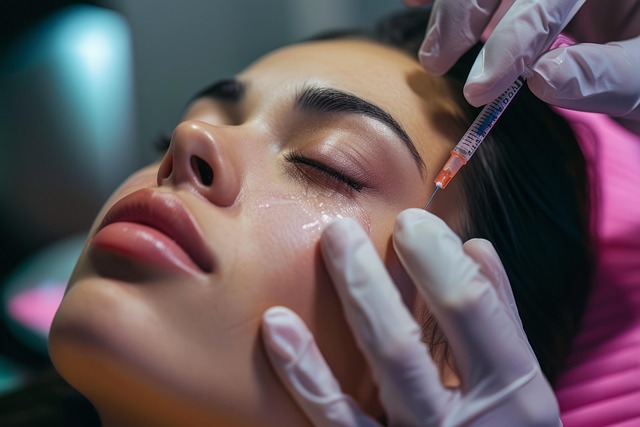Botox for facial contouring is a non-surgical procedure that relaxes specific muscle groups around the jawline and neck, reducing fat appearance and enhancing facial structure. Popular for achieving a V-shape, it offers subtle yet noticeable results lasting several months with proper care. Ideal for mild to moderate facial asymmetry or weak bone structure, safety and effectiveness depend on selecting a qualified healthcare provider. Potential side effects include temporary bruising, swelling, headaches, and muscle weakness, manageable through aftercare instructions. Regular maintenance treatments are key to sustaining desired contours.
“Botox has emerged as a sought-after solution for those seeking to enhance their facial aesthetics, particularly in achieving a defined V-line. This article delves into the world of Botox for V-Line contouring, exploring its role in redefining jawlines and cheekbones. We’ll unravel the science behind Botox’s effectiveness in facial contouring, highlighting its benefits, safety profile, and long-term maintenance. From understanding the ideal candidate to post-treatment care, this comprehensive guide offers insights into how Botox can transform your facial silhouette.”
Understanding V-Line Contouring: The Aesthetic Goal

V-Line contouring is a popular facial aesthetic technique that focuses on defining and enhancing the jawline, creating a more defined V-shape. This procedure aims to sculpt and refine the facial structure, providing a slimmer and more balanced appearance. By targeting specific muscle groups, particularly those around the jaw and neck, Botox for facial contouring can effectively reduce the appearance of fat and relax the muscles, resulting in a contoured V-line.
The aesthetic goal is to achieve a harmonious balance between the upper and lower face, creating a defined yet natural-looking jawline. This technique is often sought by individuals who desire a more angular and chiselled facial feature without the need for more invasive surgical procedures. Botox injections offer a non-surgical approach to facial contouring, providing a subtle yet noticeable enhancement that can last for several months with proper care.
How Botox Works for Facial Contouring

Botox, a protein derived from bacteria, is renowned for its ability to relax muscles and reduce the appearance of wrinkles. In the context of facial contouring, Botox for V-Line enhancement works by targeting specific muscle groups responsible for facial expressions, particularly those contributing to a square or rounded chin. When injected in precise amounts, Botox temporarily paralyses these muscles, leading to a reduction in their activity and, consequently, a slimmer appearance. This non-surgical approach offers a gradual yet effective method for achieving a desired V-Line contour, enhancing facial balance and definition without incisions or extensive recovery periods.
Benefits of Using Botox for V-Line Enhancement

Botox has emerged as a popular and effective non-surgical procedure for achieving facial contouring, particularly in enhancing the V-line. This injectable treatment offers several advantages over traditional surgical methods. One of the key benefits is its ability to provide subtle yet defined results, allowing individuals to achieve a slimmer and more angular face without undergoing invasive surgery. Botox works by relaxing specific muscle groups responsible for facial bulges, resulting in a refined appearance.
Additionally, Botox for V-line contouring offers several long-term advantages. It is a minimally invasive procedure with minimal downtime, making it an attractive option for those seeking a quick fix or wanting to avoid the extensive recovery period associated with surgery. The results are natural and gradual, ensuring a more youthful and balanced facial profile without looking overly done. This treatment also has a proven track record of safety and effectiveness when performed by qualified professionals, making it a reliable choice for anyone considering Botox for facial contouring.
Candidate Selection: Who is a Good Fit?

Botox for facial contouring, particularly focusing on V-line enhancement, is an attractive option for those seeking non-surgical alternatives to achieve a more defined jawline and cheekbones. The ideal candidate for this procedure is an individual with mild to moderate facial asymmetry or a weak bone structure who wants to refine their facial features without surgery. It’s important to note that Botox works best on people with good skin elasticity, as it helps to smoothen out the treated areas effectively.
During the consultation, our experts will evaluate your medical history and current health status to ensure you’re an appropriate candidate. They will also discuss your expectations and address any concerns you might have regarding the procedure. Those who are not suitable candidates for Botox V-line contouring may include individuals with severe facial asymmetry or those with certain medical conditions that could affect healing or muscle function.
Procedure Overview: What to Expect During Treatment

Botox for V-Line contouring is a non-surgical facial rejuvenation procedure that utilizes botulinum toxin (Botox) to enhance facial aesthetics. During treatment, a qualified healthcare provider will carefully inject tiny amounts of Botox into specific muscle groups around the jawline and cheeks, aiming to smoothen out facial wrinkles and create a more defined V-shaped contour. The procedure is typically quick and comfortable, with minimal downtime required.
Patients can expect to feel only slight discomfort during treatment, often described as a pinprick sensation. After the procedure, mild swelling or bruising may occur but usually subsides within a few days. It’s important to remember that Botox for facial contouring is not a one-size-fits-all solution; the number of injections and amount of Botox used will vary depending on individual needs and desired results.
Safety and Effectiveness Considerations

When considering Botox for V-Line contouring, safety and effectiveness should be at the forefront of your mind. This non-invasive procedure involves injecting a neurotoxin into specific facial muscles to relax them, leading to a slimmer appearance. However, it’s crucial to choose a qualified healthcare provider with extensive experience in Botox for facial contouring. Unskilled practitioners may inject incorrectly, potentially causing unwanted side effects like asymmetry, bruising, or even more severe reactions.
Additionally, while Botox is generally safe when administered correctly, individual results can vary. It’s important to have realistic expectations and understand that multiple treatments might be necessary to achieve and maintain the desired V-Line contour. Before proceeding, discuss your medical history, any medications you’re taking, and your goals openly with your provider to ensure a safe and effective experience.
Potential Side Effects and Management

Botox for facial contouring, while popular for achieving a V-line look, like any medical procedure, comes with potential side effects. These can include temporary bruising, swelling, and discomfort at the injection sites. Some individuals may also experience headaches or mild muscle weakness in the treated areas. Thankfully, these side effects are usually mild and subside within a few days.
To manage any adverse reactions, patients should follow their doctor’s aftercare instructions diligently. This typically involves resting, avoiding strenuous activities, and applying cold compresses to reduce swelling. Staying hydrated and maintaining a healthy diet can also aid in the healing process. Promptly communicating any persistent or severe symptoms to your healthcare provider is crucial for ensuring optimal care during recovery from Botox for facial contouring procedures.
Recovery Process and Post-Treatment Care

After your Botox for V-Line contouring treatment, it’s important to understand the recovery process and post-treatment care. You may experience some mild redness, swelling, or bruising at the injection sites, which is typically temporary and subsides within a few days. It’s crucial to avoid strenuous activities and excessive sun exposure during this period, as these can exacerbate inflammation.
Proper post-treatment care includes keeping the treated area clean and moisturized, applying cold compresses to reduce swelling, and taking prescribed medications to manage any discomfort. Avoid makeup and heavy creams for at least 24 hours, and be mindful of any touching or rubbing of the treatment area. Remember that individual results may vary, and your healthcare provider will offer specific guidance tailored to your needs, ensuring optimal outcomes for your Botox for facial contouring procedure.
Maintenance and Follow-Up Treatments

After your initial Botox treatment for V-Line contouring, it’s crucial to understand that results may vary and maintenance is key. While the effects of Botox can last for several months, regular follow-up treatments are often recommended to maintain the desired facial contour. This is because muscle movement over time can cause the Botox to wear off, and repeated injections can help keep the V-Line definition sharp.
During follow-up appointments, your healthcare provider will assess the current state of your treatment area, discuss any concerns or changes in your facial structure, and administer additional Botox as needed. Staying consistent with these maintenance treatments ensures optimal results, enhances natural-looking contours, and helps you achieve and maintain that desired V-shaped face.
